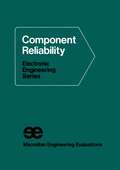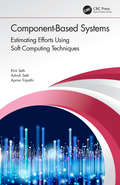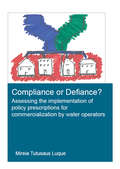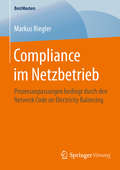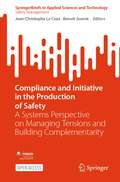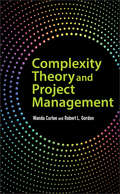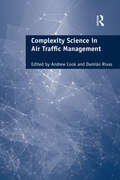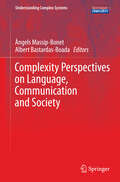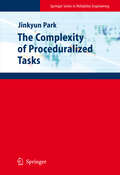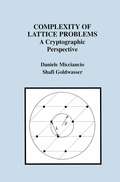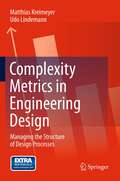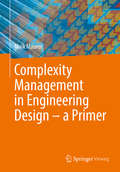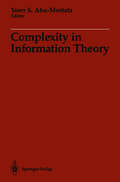- Table View
- List View
Component Models and Systems for Grid Applications: Proceedings of the Workshop on Component Models and Systems for Grid Applications held June 26, 2004 in Saint Malo, France.
by Vladimir Getov Thilo KielmannComponent Models and Systems for Grid Applications is the essential reference for the most current research on Grid technologies. This first volume of the CoreGRID series addresses such vital issues as the architecture of the Grid, the way software will influence the development of the Grid, and the practical applications of Grid technologies for individuals and businesses alike. Part I of the book, "Application-Oriented Designs", focuses on development methodology and how it may contribute to a more component-based use of the Grid. "Middleware Architecture", the second part, examines portable Grid engines, hierarchical infrastructures, interoperability, as well as workflow modeling environments. The final part of the book, "Communication Frameworks", looks at dynamic self-adaptation, collective operations, and higher-order components. With Component Models and Systems for Grid Applications, editors Vladimir Getov and Thilo Kielmann offer the computing professional and the computing researcher the most informative, up-to-date, and forward-looking thoughts on the fast-growing field of Grid studies.
Component-Based Systems: Estimating Efforts Using Soft Computing Techniques
by Kirti Seth Ashish Seth Aprna TripathiBusinesses today are faced with a highly competitive market and fast-changing technologies. In order to meet demanding customers’ needs, they rely on high quality software. A new field of study, soft computing techniques, is needed to estimate the efforts invested in component-based software. Component-Based Systems: Estimating Efforts Using Soft Computing Techniques is an important resource that uses computer-based models for estimating efforts of software. It provides an overview of component-based software engineering, while addressing uncertainty involved in effort estimation and expert opinions. This book will also instruct the reader how to develop mathematical models. This book is an excellent source of information for students and researchers to learn soft computing models, their applications in software management, and will help software developers, managers, and those in the industry to apply soft computing techniques to estimate efforts.
Component-Based Systems: Estimating Efforts Using Soft Computing Techniques
by Kirti Seth Ashish Seth Aprna TripathiBusinesses today are faced with a highly competitive market and fast-changing technologies. In order to meet demanding customers’ needs, they rely on high quality software. A new field of study, soft computing techniques, is needed to estimate the efforts invested in component-based software. Component-Based Systems: Estimating Efforts Using Soft Computing Techniques is an important resource that uses computer-based models for estimating efforts of software. It provides an overview of component-based software engineering, while addressing uncertainty involved in effort estimation and expert opinions. This book will also instruct the reader how to develop mathematical models. This book is an excellent source of information for students and researchers to learn soft computing models, their applications in software management, and will help software developers, managers, and those in the industry to apply soft computing techniques to estimate efforts.
Compliant Mechanisms: Design of Flexure Hinges
by Nicolae LobontiuFlexure hinges hold several advantages over classical rotation joints, including no friction losses, no need for lubrication, no hysteresis, compactness, capacity to be utilized in small-scale applications, ease of fabrication, virtually no assembly, and no required maintenance. Compliant Mechanisms: Design of Flexure Hinges provides practical answ
Compliant Mechanisms: Design of Flexure Hinges
by Nicolae LobontiuWith a rigorous and comprehensive coverage, the second edition of Compliant Mechanisms: Design of Flexure Hinges provides practical answers to the design and analysis of devices that incorporate flexible hinges. Complex-shaped flexible-hinge mechanisms are generated from basic elastic segments by means of a bottom-up compliance (flexibility) approach. The same compliance method and the classical finite element analysis are utilized to study the quasi-static and dynamic performances of these compliant mechanisms. This book offers easy-to-use mathematical tools to investigate a wealth of flexible-hinge configurations and two- or three-dimensional compliant mechanism applications. FEATURES Introduces a bottom-up compliance-based approach to characterize the flexibility of new and existing flexible hinges of straight- and curvilinear-axis configurations Develops a consistent linear lumped-parameter compliance model to thoroughly describe the quasi-static and dynamic behavior of planar/spatial, serial/parallel flexible-hinge mechanisms Utilizes the finite element method to analyze the quasi-statics and dynamics of compliant mechanisms by means of straight- and curvilinear-axis flexible-hinge elements Covers miscellaneous topics such as stress concentration, yielding and related maximum load, precision of rotation of straight- and circular-axis flexible hinges, temperature effects on compliances, layered flexible hinges and piezoelectric actuation/sensing Offers multiple solved examples of flexible hinges and flexible-hinge mechanisms. This book should serve as a reference to students, researchers, academics and anyone interested to investigate precision flexible-hinge mechanisms by linear model-based methods in various areas of mechanical, aerospace or biomedical engineering, as well as in robotics and micro-/nanosystems.
Compliant Mechanisms: Design of Flexure Hinges
by Nicolae LobontiuWith a rigorous and comprehensive coverage, the second edition of Compliant Mechanisms: Design of Flexure Hinges provides practical answers to the design and analysis of devices that incorporate flexible hinges. Complex-shaped flexible-hinge mechanisms are generated from basic elastic segments by means of a bottom-up compliance (flexibility) approach. The same compliance method and the classical finite element analysis are utilized to study the quasi-static and dynamic performances of these compliant mechanisms. This book offers easy-to-use mathematical tools to investigate a wealth of flexible-hinge configurations and two- or three-dimensional compliant mechanism applications. FEATURES Introduces a bottom-up compliance-based approach to characterize the flexibility of new and existing flexible hinges of straight- and curvilinear-axis configurations Develops a consistent linear lumped-parameter compliance model to thoroughly describe the quasi-static and dynamic behavior of planar/spatial, serial/parallel flexible-hinge mechanisms Utilizes the finite element method to analyze the quasi-statics and dynamics of compliant mechanisms by means of straight- and curvilinear-axis flexible-hinge elements Covers miscellaneous topics such as stress concentration, yielding and related maximum load, precision of rotation of straight- and circular-axis flexible hinges, temperature effects on compliances, layered flexible hinges and piezoelectric actuation/sensing Offers multiple solved examples of flexible hinges and flexible-hinge mechanisms. This book should serve as a reference to students, researchers, academics and anyone interested to investigate precision flexible-hinge mechanisms by linear model-based methods in various areas of mechanical, aerospace or biomedical engineering, as well as in robotics and micro-/nanosystems.
Compliance or Defiance?: Assessing the Implementation of Policy Prescriptions for Commercialization by Water Operators (IHE Delft PhD Thesis Series)
by Mireia TutusausWhereas the global water community may have reached consensus on the need for water providers to operate on the basis of commercial principles, staff of water utilities are faced with the challenge of implementing these principles in their everyday work. In the everyday domain, these principles appear to directly conflict with the mandate of water operators to provide water services to all. Moreover, the socio-political, economic and bio-physical context in which these water operate may be ill-suited to implement commercialization. In pursuing commercialization these operators adapt, reinterpret, modify, deflect, alter or betray the original principles of commercialization during implementation. This research takes inspiration from the rich literature on policy implementation and policy translation, which argues that policy models need to be transformed and modified if they are to be successfully adopted or implemented. This research analyzes the alterations visible in the daily implementation of commercial models of water provisioning and, in doing so, present a better understanding of how water operators implement policy prescriptions of commercialization in practice. Based on the analysis of the adaptations and (re)interpretations of the implemented model of commercialization in the different cases, this thesis argues that a new way of speaking about commercialization should be developed.
Compliance or Defiance?: Assessing the Implementation of Policy Prescriptions for Commercialization by Water Operators (IHE Delft PhD Thesis Series)
by Mireia TutusausWhereas the global water community may have reached consensus on the need for water providers to operate on the basis of commercial principles, staff of water utilities are faced with the challenge of implementing these principles in their everyday work. In the everyday domain, these principles appear to directly conflict with the mandate of water operators to provide water services to all. Moreover, the socio-political, economic and bio-physical context in which these water operate may be ill-suited to implement commercialization. In pursuing commercialization these operators adapt, reinterpret, modify, deflect, alter or betray the original principles of commercialization during implementation. This research takes inspiration from the rich literature on policy implementation and policy translation, which argues that policy models need to be transformed and modified if they are to be successfully adopted or implemented. This research analyzes the alterations visible in the daily implementation of commercial models of water provisioning and, in doing so, present a better understanding of how water operators implement policy prescriptions of commercialization in practice. Based on the analysis of the adaptations and (re)interpretations of the implemented model of commercialization in the different cases, this thesis argues that a new way of speaking about commercialization should be developed.
Compliance im Netzbetrieb: Prozessanpassungen bedingt durch den Network Code on Electricity Balancing (BestMasters)
by Markus RieglerMarkus Riegler beschreibt die für eine operative Prozessgestaltung relevanten Inhalte des Network Code on Electricity Balancing und entwirft, darauf aufbauend, zwei unterschiedliche Prozesslandschaften. Der Autor untersucht, wie diese Anforderungen am effizientesten in die Prozessstrukturen der europäischen Übertragungsnetzbetreiber eingebettet werden können. Im ersten Entwurf verbleiben die Aufgaben soweit wie möglich im Verantwortungsbereich der Übertragungsnetzbetreiber. Der zweite beschreibt ein Szenario, in dem so viele Aufgaben wie möglich an zentrale europäische Entitäten delegiert werden. Abschließend werden die beiden Prozesslandschaften einander gegenübergestellt, um den Aufwand für die Gestaltungsvarianten zu bestimmen.
Compliance and Initiative in the Production of Safety: A Systems Perspective on Managing Tensions and Building Complementarity (SpringerBriefs in Applied Sciences and Technology)
by Jean-Christophe Le Coze Benoît JournéThis open access book addresses the idea that there are two ways to go about achieving a safe working environment. The text challenges the prevailing notion that compliance with a rule system, imposed from the top of an organization and designed to anticipate possible hazards in system operation, is really incompatible with the idea that the professional expertise of front-line workers is what promotes safe outcomes despite inevitable unanticipated perturbations. The contributors, drawn from academic and industrial backgrounds, demonstrate that rather than being at odds with each other, rules-compliance and proactivity are in fact complementary resources the coexistence of which increases safety. Furthermore, the implications of this approach extend beyond safety, being relevant to business performance, strategies for innovation and system resilience as well.The book steps back from an exclusive focus on front-line work to explore the way in which compliance and initiative are articulated at different levels within the hierarchy of a firm, right up to that of top management. Further, the contributors analyze the way in which safety authorities, the justice system, and the general public perceive and interpret such strategies, in particular in the aftermath of major events.This book deals with issues of interest to researchers and graduate students in safety science and organization studies and to members of expert bodies and experts in industry and consultancy concerned with similar subjects.
Complexity Theory and Project Management: Complexity Theory, Communication, And Leadership (Coursesmart Ser. #7)
by Wanda Curlee Robert L. GordonAn insightful view on how to use the power of complexity theory to manage projects more successfully Current management practices require adherence to rigid, global responses unsuitable for addressing the changing needs of most projects. Complexity Theory and Project Management shifts this paradigm to create opportunities for expanding the decision-making process in ways that promote flexibility—and increase effectiveness. It informs readers on the managerial challenges of juggling project requirements, and offers them a clear roadmap on how to revise perspectives and reassess priorities to excel despite having an unpredictable workflow. One of the first books covering the subject of complexity theory for project management, this useful guide: Explains the relationship of complexity theory to virtual project management Supplies techniques, tips, and suggestions for building effective and successful teams in the virtual environment Presents current information about best practices and relevant proactive tools Makes a strong case for including complexity theory in PMI®'s PMBOK® Guide Complexity Theory and Project Management gives a firsthand view on the future of complexity theory as a driving force in the management field, and allows project managers to get a head start in applying its principles immediately to produce more favorable outcomes. (PMI and PMBOK are registered marks of the Project Management Institute, Inc.)
Complexity Theory and Project Management
by Wanda Curlee Robert L. GordonAn insightful view on how to use the power of complexity theory to manage projects more successfully Current management practices require adherence to rigid, global responses unsuitable for addressing the changing needs of most projects. Complexity Theory and Project Management shifts this paradigm to create opportunities for expanding the decision-making process in ways that promote flexibility—and increase effectiveness. It informs readers on the managerial challenges of juggling project requirements, and offers them a clear roadmap on how to revise perspectives and reassess priorities to excel despite having an unpredictable workflow. One of the first books covering the subject of complexity theory for project management, this useful guide: Explains the relationship of complexity theory to virtual project management Supplies techniques, tips, and suggestions for building effective and successful teams in the virtual environment Presents current information about best practices and relevant proactive tools Makes a strong case for including complexity theory in PMI®'s PMBOK® Guide Complexity Theory and Project Management gives a firsthand view on the future of complexity theory as a driving force in the management field, and allows project managers to get a head start in applying its principles immediately to produce more favorable outcomes. (PMI and PMBOK are registered marks of the Project Management Institute, Inc.)
Complexity Theories of Cities Have Come of Age: An Overview with Implications to Urban Planning and Design
by Juval Portugali, Han Meyer, Egbert Stolk and Ekim TanToday, our cities are an embodiment of the complex, historical evolution of knowledge, desires and technology. Our planned and designed activities co-evolve with our aspirations, mediated by the existing technologies and social structures. The city represents the accretion and accumulation of successive layers of collective activity, structuring and being structured by other, increasingly distant cities, reaching now right around the globe.This historical and structural development cannot therefore be understood or captured by any set of fixed quantitative relations. Structural changes imply that the patterns of growth, and their underlying reasons change over time, and therefore that any attempt to control the morphology of cities and their patterns of flow by means of planning and design, must be dynamical, based on the mechanisms that drive the changes occurring at a given moment.This carefully edited post-proceedings volume gathers a snapshot view by leading researchers in field, of current complexity theories of cities. In it, the achievements, criticisms and potentials yet to be realized are reviewed and the implications to planning and urban design are assessed.
Complexity Science in Air Traffic Management
by Andrew Cook Damián RivasAir traffic management (ATM) comprises a highly complex socio-technical system that keeps air traffic flowing safely and efficiently, worldwide, every minute of the year. Over the last few decades, several ambitious ATM performance improvement programmes have been undertaken. Such programmes have mostly delivered local technological solutions, whilst corresponding ATM performance improvements have fallen short of stakeholder expectations. In hindsight, this can be substantially explained from a complexity science perspective: ATM is simply too complex to address through classical approaches such as system engineering and human factors. In order to change this, complexity science has to be embraced as ATM's 'best friend'. The applicability of complexity science paradigms to the analysis and modelling of future operations is driven by the need to accommodate long-term air traffic growth within an already-saturated ATM infrastructure. Complexity Science in Air Traffic Management is written particularly, but not exclusively, for transport researchers, though it also has a complementary appeal to practitioners, supported through the frequent references made to practical examples and operational themes such as performance, airline strategy, passenger mobility, delay propagation and free-flight safety. The book should also have significant appeal beyond the transport domain, due to its intrinsic value as an exposition of applied complexity science and applied research, drawing on examples of simulations and modelling throughout, with corresponding insights into the design of new concepts and policies, and the understanding of complex phenomena that are invisible to classical techniques.
Complexity Science in Air Traffic Management
by Andrew Cook Damián RivasAir traffic management (ATM) comprises a highly complex socio-technical system that keeps air traffic flowing safely and efficiently, worldwide, every minute of the year. Over the last few decades, several ambitious ATM performance improvement programmes have been undertaken. Such programmes have mostly delivered local technological solutions, whilst corresponding ATM performance improvements have fallen short of stakeholder expectations. In hindsight, this can be substantially explained from a complexity science perspective: ATM is simply too complex to address through classical approaches such as system engineering and human factors. In order to change this, complexity science has to be embraced as ATM's 'best friend'. The applicability of complexity science paradigms to the analysis and modelling of future operations is driven by the need to accommodate long-term air traffic growth within an already-saturated ATM infrastructure. Complexity Science in Air Traffic Management is written particularly, but not exclusively, for transport researchers, though it also has a complementary appeal to practitioners, supported through the frequent references made to practical examples and operational themes such as performance, airline strategy, passenger mobility, delay propagation and free-flight safety. The book should also have significant appeal beyond the transport domain, due to its intrinsic value as an exposition of applied complexity science and applied research, drawing on examples of simulations and modelling throughout, with corresponding insights into the design of new concepts and policies, and the understanding of complex phenomena that are invisible to classical techniques.
Complexity Perspectives on Language, Communication and Society (Understanding Complex Systems)
by Àngels Massip-Bonet Albert Bastardas-BoadaThe “language-communication-society” triangle defies traditional scientific approaches. Rather, it is a phenomenon that calls for an integration of complex, transdisciplinary perspectives, if we are to make any progress in understanding how it works. The highly diverse agents in play are not merely cognitive and/or cultural, but also emotional and behavioural in their specificity. Indeed, the effort may require building a theoretical and methodological body of knowledge that can effectively convey the characteristic properties of phenomena in human terms.New complexity approaches allow us to rethink our limited and mechanistic images of human societies and create more appropriate emo-cognitive dynamic and holistic models. We have to enter into dialogue with the complexity views coming out of other more ‘material’ sciences, but we also need to take steps in the linguistic and psycho-sociological fields towards creating perspectives and concepts better fitted to human characteristics.Our understanding of complexity is different – but not opposed – to the one that is more commonly found in texts written by people working in physics or computer science, for example. The goal of this book is to extend the knowledge of these other more ‘human’ or socially oriented perspectives on complexity, taking account of the language and communication singularities of human agents in society. Our understanding of complexity is different – but not opposed – to the one that is more commonly found in texts written by people working in physics or computer science, for example. The goal of this book is to extend the knowledge of these other more ‘human’ or socially oriented perspectives on complexity, taking account of the language and communication singularities of human agents in society.
The Complexity of Proceduralized Tasks (Springer Series in Reliability Engineering)
by Jinkyun ParkWe think we have scientific knowledge when we know the cause. (Aristotle, Posterior Analytics Book II, Part 11) About 12 years ago, when I was a graduate student, many people were concerned about my Ph. D. topic – investigating the effect of the complexity of procedu- lized tasks on the performance of human operators working in nuclear power plants. Although they agreed with the fact that procedures (especially emergency operating procedures) play a crucial role in securing the safety of nuclear power plants, it was amazing that most of them pointed out a very similar issue: “I cannot understand why operating personnel see any difficulty (or complexity) in condu- ing procedures, because all that they have to do is to follow a simple IF-THEN- ELSE rule as written. ” Actually, this issue is closely related to one of the main questions I was recently asked, such as “Don’t you think your work is too acad- ic to apply to actual procedures?” or “I guess we don’t need to consider the c- plexity of procedures, because we can develop a good procedure using many pr- tical procedure writers’ guidelines. Then what is the real contribution of your work?” I absolutely agree with the latter comment. Yes, we can develop a good pro- dure with the support of many practical and excellent guidelines.
Complexity of Lattice Problems: A Cryptographic Perspective (The Springer International Series in Engineering and Computer Science #671)
by Daniele Micciancio Shafi GoldwasserLattices are geometric objects that can be pictorially described as the set of intersection points of an infinite, regular n-dimensional grid. De spite their apparent simplicity, lattices hide a rich combinatorial struc ture, which has attracted the attention of great mathematicians over the last two centuries. Not surprisingly, lattices have found numerous ap plications in mathematics and computer science, ranging from number theory and Diophantine approximation, to combinatorial optimization and cryptography. The study of lattices, specifically from a computational point of view, was marked by two major breakthroughs: the development of the LLL lattice reduction algorithm by Lenstra, Lenstra and Lovasz in the early 80's, and Ajtai's discovery of a connection between the worst-case and average-case hardness of certain lattice problems in the late 90's. The LLL algorithm, despite the relatively poor quality of the solution it gives in the worst case, allowed to devise polynomial time solutions to many classical problems in computer science. These include, solving integer programs in a fixed number of variables, factoring polynomials over the rationals, breaking knapsack based cryptosystems, and finding solutions to many other Diophantine and cryptanalysis problems.
Complexity Metrics in Engineering Design: Managing the Structure of Design Processes
by Matthias Kreimeyer Udo LindemannThis book presents the results of several years’ research work on how to characterize complexity in engineering design with a specific regard to dependency modeling. The 52 complexity metrics that are presented show different facets of how complexity takes shape in design processes. The metrics are supported by a modeling method and a measurement framework to employ the metrics in a goal-oriented manner. The detailed description of all involved metrics and models makes it possible to apply the analysis approach to common process modeling methodologies. Three case studies from automotive process management illustrate the application to facilitate the transfer to other cases in an industrial context. The comprehensive appendix supplies additional details and checklists for structural analysis to generate a complete overview of current means of structural analysis.
Complexity Management in Fuzzy Systems: A Rule Base Compression Approach (Studies in Fuzziness and Soft Computing #211)
by Alexander GegovThis book presents a systematic study on the inherent complexity in fuzzy systems, resulting from the large number and the poor transparency of the fuzzy rules. The study uses a novel approach for complexity management, aimed at compressing the fuzzy rule base by removing the redundancy while preserving the solution. The compression is based on formal methods for presentation, manipulation, transformation and simplification of fuzzy rule bases.
Complexity Management in Engineering Design – a Primer
by Maik MaurerThe treatise supports understanding the phenomena of complexity in engineering, distinguishes complexity from other challenges and presents an overview of definitions and applied approaches.The historical background of complexity management is explained by highlighting the important epochs, their key actors and their discoveries, findings and developments. Knowing about the appearance of early system awareness in ancient Greece, the creation of mechanical philosophy in the 17th century and the discovery of classic physics enables the reader to better comprehend modern system sciences and management approaches.A classification of complexity management approaches by research fields indicates current focus areas and starting points for future discussions. In a comprehensive map, the classification points out mutual overlaps between engineering disciplines in terms of similar complexity management approaches.Finally, the treatise introduces a generic complexity management framework, which is based on structural management approaches.
Complexity in International Security: A Holistic Spatial Approach
by Peter Simon SapatyIn September 2018, the 73rd General Assembly of the United Nations acknowledged that international instability is increasing and that improving global security is among the most important tasks facing the world today. The Assembly concluded that it is extremely important to develop new, effective frameworks and technologies to understand and confront increasingly complex networks of actors, interests, and contexts. Leading international security expert Peter Sapaty meets this challenge head-on and introduces a new, high-level distributed processing and control approach capable of finding real-time solutions for irregularities, crises, and security problems emerging any time and in any part of the world. Drawing upon the principles of Gestalt psychology, this book develops a radically new model of technology, Spatial Grasp Technology (SGT), a self-navigating, self-replicating, self-modifying spatial pattern technology expressed in a special high-level recursive language. Through rigorous theoretical argument and many practical examples, Sapaty shows how SGT can account for millions to billions of nodes distributed worldwide without vulnerable central resources; explains why SGT is hundreds of times shorter, simpler, and faster than other models and languages; and shows that SGT's technology basics are so simple that they can be effectively implemented even in a short time by a small group of system programmers within traditional university environments. Perhaps most importantly, Sapaty demonstrates how SGT is capable of implementing security scenarios not only at run time, but also conceivably ahead of it, allowing in some cases for the prediction and even prevention of local or global crises. For the novelty, simplicity, and wide applicability of its approach, Complexity in International Security is essential reading for system scientists, application programmers, industry managers, security and defence personnel, and university students interested in advanced MSc and PhD projects in the area of holistic and distributed management.
Complexity in International Security: A Holistic Spatial Approach
by Peter Simon SapatyIn September 2018, the 73rd General Assembly of the United Nations acknowledged that international instability is increasing and that improving global security is among the most important tasks facing the world today. The Assembly concluded that it is extremely important to develop new, effective frameworks and technologies to understand and confront increasingly complex networks of actors, interests, and contexts. Leading international security expert Peter Sapaty meets this challenge head-on and introduces a new, high-level distributed processing and control approach capable of finding real-time solutions for irregularities, crises, and security problems emerging any time and in any part of the world. Drawing upon the principles of Gestalt psychology, this book develops a radically new model of technology, Spatial Grasp Technology (SGT), a self-navigating, self-replicating, self-modifying spatial pattern technology expressed in a special high-level recursive language. Through rigorous theoretical argument and many practical examples, Sapaty shows how SGT can account for millions to billions of nodes distributed worldwide without vulnerable central resources; explains why SGT is hundreds of times shorter, simpler, and faster than other models and languages; and shows that SGT's technology basics are so simple that they can be effectively implemented even in a short time by a small group of system programmers within traditional university environments. Perhaps most importantly, Sapaty demonstrates how SGT is capable of implementing security scenarios not only at run time, but also conceivably ahead of it, allowing in some cases for the prediction and even prevention of local or global crises. For the novelty, simplicity, and wide applicability of its approach, Complexity in International Security is essential reading for system scientists, application programmers, industry managers, security and defence personnel, and university students interested in advanced MSc and PhD projects in the area of holistic and distributed management.
Complexity in Information Theory
by Yaser S. Abu-MostafaThe means and ends of information theory and computational complexity have grown significantly closer over the past decade. Common analytic tools, such as combinatorial mathematics and information flow arguments, have been the cornerstone of VLSl complexity and cooperative computation. The basic assumption of limited computing resources is the premise for cryptography, where the distinction is made between available information and accessible information. Numerous other examples of common goals and tools between the two disciplines have shaped a new research category of 'information and complexity theory'. This volume is intended to expose to the research community some of the recent significant topics along this theme. The contributions selected here are all very basic, presently active, fairly well-established, and stimulating for substantial follow-ups. This is not an encyclopedia on the subject, it is concerned only with timely contributions of sufficient coherence and promise. The styles of the six chapters cover a wide spectrum from specific mathematical results to surveys of large areas. It is hoped that the technical content and theme of this volume will help establish this general research area. I would like to thank the authors of the chapters for contributing to this volume. I also would like to thank Ed Posner for his initiative to address this subject systematically, and Andy Fyfe and Ruth Erlanson for proofreading some of the chapters.
